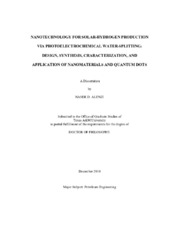| dc.description.abstract | Hydrogen production by water-splitting using solar energy and nanostructure
photocatalysts is very promising as a renewable, efficient, environmentally clean
technology. The key is to reduce the cost of hydrogen production as well as increase the
solar-to-hydrogen conversion efficiency by searching for cost-effective photocatalytic
materials. In this dissertation, energy efficiency calculation was carried out based on
hydrogen production observation to evaluate the nanomaterials activity. The results are
important to gain better understanding of water-splitting reaction mechanism. Design,
synthesis, characterization/properties and application of these nanomaterials was the
road-map to achieve the research objectives. The design of TiO2 is selected based on
unique photocatalytic and photovoltaic properties and high stability in aqueous solution.
Various structures of nanocomposites TiO2 were designed according to their
characteristics and potential activity. TiO2 with quantum dots, nanocomposites thin film,
nanofibers, nanorods, nanowires (core/shell), nanotubes, nanopowders, nanoparticles,
and nanosphere decorated with low cost metals, sensitized with dye, and doped with nitrogen are designed. Green physical and chemical synthesis methods such as sol-gel
techniques, autoclave, microwave, electrospinning, wet impregnation, hydrothermal,
chemical vapor deposition, template-based fabrication (porous anodic aluminium oxide
membrane), drop casting, dip coating, wet coating were used to synthesize and fabricate
the nanomaterials and quantum dots.Both bottom-up and top-down synthesis techniques
were used. The ability to control and manipulate the size, shape/geometry, crystal
structure, chemical compositions, interaction and interface properties of these materials
at nano-scale during the synthesis enable to enhance their thermal, optical, chemical,
electrical, …etc properties. Several characterization techniques such as XRD, XPS,
EDS, SEM, UV-visible spectra, and optical microscopic and digital camera were also
obtained to characterize the properties and confirm to achieve the desired design. The
application or processing to test the activity of these nanomaterials for hydrogen
production by water-splitting was conducted through extensive experimental program. It
was carried out in a one photo-single column experimental set-up to detect hydrogen
evolution. A high throughput screening process to evaluate single photo reduction
catalysts was established here for simplicity, safety, cost-effective and flexibility of
testing nanomaterials for water photoreduction reactivity and hydrogen generation.
Therefore, methanol as electron donor or oxidation agent was mixed with water in equal
volume ratio in order to prevent the oxygen evolution and only measured the time course
of hydrogen production. The primary objectives of this study is to investigate the
following (1) The structure-properties relationship through testing quantum dots,
nanocomposites thin film, nanofibers, nanorods, nanowires (core/shell), nanotubes, nanopowders, nanoparticles, nanospheres of TiO2 decorated with metals, dye
sensitization, and nitrogen-doping. (2) The role of adding electron donors/relays to
solution and their effect on semiconductor surface-electrolyte interface under constant
conditions such as KI, Mv 2, NaCl, NaHCO3, sea and pure water. (3) Band gap and
defect engineering by cation and anion doping. (4) Quantum dots and dye sensitization
effect. The nanomaterials activity evaluated based on observed hydrogen production
rate (μmol/h/g) experimentally and based on the energy efficiency (percent) calculation.
Major findings in this dissertation are (1) A high throughput screening process to
evaluate single photoreduction catalysts for solar-hydrogen production by water-splitting
was established. (2) nanofibers structure of TiO2 doped with nitrogen, sensitized with
dye (Rose Bengal Sodium) and quantum dots (CuInS2), and decorated with metals (Ag)
showed the high solar-to-hydrogen conversion efficiency and high hydrogen production
rate (3) Simple, safe, inexpensive, robust, efficient and green physical and chemical
synthesis methods were used to prepare the nanomaterials and quantum dots. (4) Gaining
insight and better understanding of water-splitting reaction mechanism by (a) Studying
the structure-properties relationship of nanomaterials (b) Studying the role of additives
on surface-interface chemistry of semiconductor and electrolyte (c) Knowing how to
reduce the electron-hole recombination reactions to enhance quantum efficiency (d)
Extending the absorption of nanomaterials to harness the visible light of solar spectrum
radiation by doping and defect chemistry. | en |


